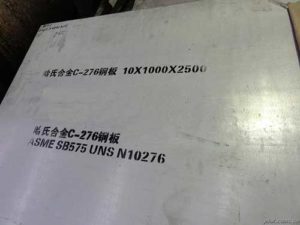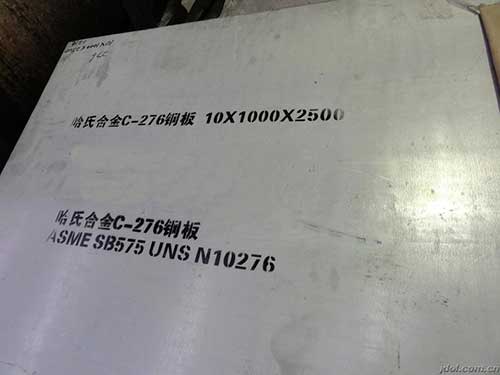Antisepsis method and material(Hastelloy C-276) for inner surface of desulfurization tower.(HY-industry technical centre)
-
Nickel-based corrosion-resistant alloy plate
 Hastelloy C-276 alloy has excellent corrosion resistance to most corrosive media under oxidation and reduction. The corrosion rate of Hastelloy C-276 alloy in 10% sulfuric acid boiling test solution is 0.35mm / y, while 316L 1.615mm / y, 317 is 0.785mm / y; Hastelloy C-276 alloy material has high initial cost, which restricts the application of Hastelloy C-276 corrosion-resistant alloy in desulfurization chimney. With Hastelloy C-276 lining, anti-corrosion measures are not necessary on the inside of the alloy plate. Steel inner tube steel plate and Hastelloy C-276 lined alloy plate are available in factory rolled composite and on-site hanging methods. HASTELLOY C-276 alloy is widely used in desulfurization towers and chimneys.
Hastelloy C-276 alloy has excellent corrosion resistance to most corrosive media under oxidation and reduction. The corrosion rate of Hastelloy C-276 alloy in 10% sulfuric acid boiling test solution is 0.35mm / y, while 316L 1.615mm / y, 317 is 0.785mm / y; Hastelloy C-276 alloy material has high initial cost, which restricts the application of Hastelloy C-276 corrosion-resistant alloy in desulfurization chimney. With Hastelloy C-276 lining, anti-corrosion measures are not necessary on the inside of the alloy plate. Steel inner tube steel plate and Hastelloy C-276 lined alloy plate are available in factory rolled composite and on-site hanging methods. HASTELLOY C-276 alloy is widely used in desulfurization towers and chimneys.
-
Titanium plate (TiCr2) lining
Titanium has good stability in acidic, alkaline, and neutral saline solutions and oxidizing media. Titanium corrosion is generally uniform corrosion and pore corrosion. Depending on the combustion medium, its oxidizing substances are different, and the environment Depending on the medium, the rules for the formation of the oxide film are different. If it follows the logarithmic law, the film is protective; if it follows the linear law, it is not protective and the corrosion is rapid.
After the oxide film is destroyed, the corrosion rate of titanium is greater than that of steel if there is no environmental medium for repair. The corrosion resistant medium of titanium refers to those media that can make the titanium passivation film in a stable state. These media are oxidizing Neutral, weakly reducing. Dilute sulfuric acid is weakly oxidizing and belongs to non-oxidizing acid. The effect of oxide repair is extremely limited. The properties of titanium are extremely closely related to the temperature, its morphology and purity.
Dense metal titanium is quite stable in nature. The presence of impurities in titanium significantly affects the physical, chemical, mechanical and corrosion resistance of titanium. In particular, some interstitial impurities can distort the titanium lattice and affect the various properties of titanium. At room temperature, the chemical activity of titanium is very small, and it can react with a few substances such as hydrofluoric acid. However, as the temperature increases, the activity of titanium rapidly increases, especially at high temperatures, titanium can react violently with many substances and cause corrosion. Therefore, the actual smoke composition and dew condensation of the project should be analyzed and applied.
-
Foamed acid-resistant glass brick lining



